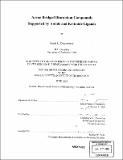Arene bridged diuranium compounds supported by amide and ketimide ligands
Author(s)
Diaconescu, Paula L. (Paula Loredana), 1976-
DownloadFull printable version (17.05Mb)
Other Contributors
Massachusetts Institute of Technology. Dept. of Chemistry.
Advisor
Christopher C. Cummins.
Terms of use
Metadata
Show full item recordAbstract
Chapter 1: The Intriguing Geometric and Electronic Structure of Arene-Bridged Diuranium Tetrakisamido Complexes The focus of this chapter is to characterize and contextualize the bridged arene complex (-toluene)U2(N[t-Bu]Ar)4 (lb2-gl-toluene, Ar = 3,5-C6H3Me2). To do so, lb2-g-toluene is compared extensively with the mononuclear complexes (THF)U(N[1Ad]Ar)3 (2a-THF, THF = tetrahydrofuran), JIU(N[t-Bu]Ar)3 (la-I), IU(N['Ad]Ar)3 (2a-I), and Me3SiNU(N[1Ad]Ar)3 (2a- NSiMe3). In order to understand the properties of a unique compound such as lb2-pg-toluene, the rest of the series is based on classical uranium amide compounds. The syntheses, structures (X-ray crystal structures and solution behavior based on variable temperature, VT, NMR data), spectroscopic (X-ray absorption near-edge structure, XANES, and electronic absorption - UV- vis-NIR) and magnetic properties are discussed and interpreted with reference to results of density functional theory (DFT) calculations performed on model compounds. Reactivity studies of lb2-p-toluene are then presented and analyzed. Chapter 2: Arene Bridged Diuranium Complexes Supported by a Ketimide Ligand: Even and Odd Electron Redox Pairs The ketimide ligand NC[t-Bu]Mes (Mes = 2,4,6-C6H2Me3) employed in the present study allows for retention of three supporting ligands per uranium, giving rise to a three-legged piano stool geometry, and it also allows for incorporation of potassium ions as tight ion pairs. The generality of such a ligand is well supported by the existence of the two types of compounds M2(g-arene)U2(NC[t-Bu]Mes)6 (M2-32-g-arene, M = Na, K) and K-32-pt-arene, when the arene is naphthalene, biphenyl, trans-stilbene, or p-terphenyl. (cont.) When toluene or benzene is the bridging arene, only odd electron species are formed including symmetrical complexes, K21-32- -arene', and asymmetrical complexes, K(DME)-32-g1-arene' (arene' = benzene, toluene). The reactivity patterns observed for the bridging arene ketimide compounds are complicated by loss of an alkali metal ion (K2-32-jg-arene with PhSSPh) or by additional redox processes (K-32-gl-arene with PhNNPh), but interesting products have been isolated. By contrast, the reaction of K2-32-g-arene with 1,3,5,7-cyclooctatetraene appears to be straightforward leading to K-3-COT. Compound 32-I-COT obtained from reaction of K-3-COT with 3-I-DME is an interesting example of an inverted sandwich and can be referred to as "inverted uranocene". Chapter 3: Uranium 2,2'-Bipyridyl Complexes Supported by Amide and Ketimide Ligands The synthesis and characterization of (bipy)2U(N[t-Bu]Ar)2 (lb-(bipy)2, bipy = 2,2'-bipyridyl, Ar = 3,5-C6H3Me2), (bipy)U(N[1Ad]Ar)3 (2a-bipy), (bipy)2U(NC[t-Bu]Mes)3 (3-(bipy)2, Mes = 2,4,6-C6H2Me3), and IU(bipy)(NC[t-Bu]Mes)3 (3-I-bipy) are reported. X-ray crystallography indicates that bipy coordinates as a radical anion in lb-(bipy)2 and 2a-bipy, and as a neutral ligand in 3-I-bipy. In 3-(bipy)2, one of the ligands is best viewed as a radical anion, while the other as a neutral ligand. These results are supported by NMR spectroscopy results of exchange experiments with 4,4'-dimethyl-2,2'-bipyridyl (dmb) and optical spectroscopy. In all complexes uranium is assigned a +4 formal oxidation state.
Description
Thesis (Ph. D.)--Massachusetts Institute of Technology, Dept. of Chemistry, 2003. Vita. Includes bibliographical references.
Date issued
2003Department
Massachusetts Institute of Technology. Department of ChemistryPublisher
Massachusetts Institute of Technology
Keywords
Chemistry.